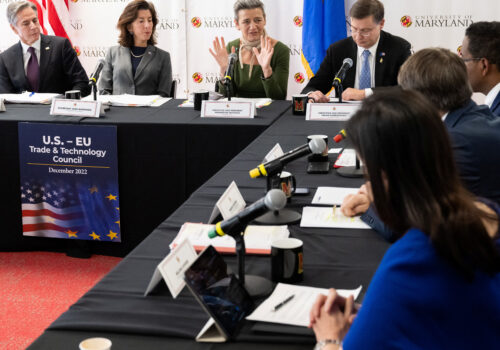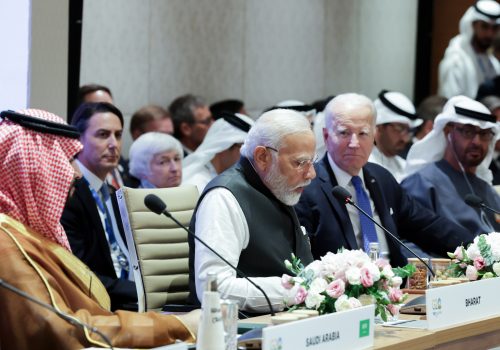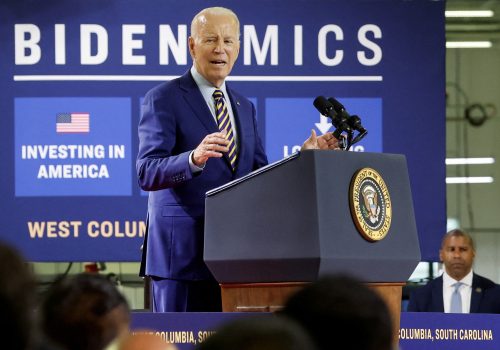It’s a new era for US-India relations, except at the WTO. That needs to change.
The first quarter of the twenty-first century has witnessed a remarkable initiation and maturing of the US-India strategic and economic relationship in ways that could not have seemed possible several decades ago. The relationship’s latest manifestations saw Prime Minister Narendra Modi travel to Washington in June 2023 for a state visit and address to Congress, followed by Modi and US President Joe Biden publicly cementing their close partnership on the margins of the Group of Twenty (G20) Summit in Delhi in November.
On the economic front, bilateral trade is blossoming, now exceeding two hundred billion dollars annually, with both sides pledging to grow it to five hundred billion dollars in the coming years. The United States and India collaborate across a half-dozen bilateral and regional groupings, including the Trade Policy Forum (TPF), the Commercial Dialogue and CEO Forum, the Initiative on Critical and Emerging Technology, the 2+2 Strategic Dialogue, and the Quadrilateral Security Dialogue, known as the Quad. On China, they have shared, if not identical, interests. They are the two largest democracies by population, and the large Indian diaspora in the United States has helped build stronger ties between the two countries in recent decades.
It is a new era for US-India relations, marked by increased collaboration, with one stark exception. In contrast to the spirit of friendship on other fronts, India and the United States are carrying on their roles as virtual arch enemies in the World Trade Organization (WTO). This dynamic plays out daily in Geneva between their diplomatic missions, and every two years or so in a ministerial conference, when the WTO attracts its biggest global headlines. It is almost as if they have been cast in a B-movie thriller with multiple sequels that audiences have long tired of watching.
Every trade dispute is in some sense unique in its own way. But the crux of the US-India rivalry at the WTO is over whether its rules should be rewritten to allow even more policy space for self-designated developing countries (which is India’s view) or if its rules need to be further strengthened to better address nonmarket behavior and to expect much more from large developing countries, such as India and China (which is the United States’ view). Too often, this debate between the United States and India is rhetorical and ignores discrete areas where they could have some shared interest, such as digital trade and the challenge of China in global trade.
If they can do this on the bilateral front, why can’t they find paths forward on a more regular basis on multilateral trade in the WTO?
The next WTO ministerial conference takes place in Abu Dhabi at the end of February, and it will likely present scenes of drama and showdown as the United States and India take center stage—again. Just over a decade ago in Bali, the two spent nearly forty-eight sleepless hours battling out the big issues as Roberto Azevêdo, then WTO director-general, engaged in shuttle diplomacy to forge a compromise between the two that other members accepted enthusiastically. The next year, the United States and India ironed out a conflict over implementation of the Bali package while others sat on the sidelines to let them resolve it. In Buenos Aires in 2017, the Trump administration’s trade representative, Robert Lighthizer, had the green light to stand firm against deals, but Indian Trade Minister Suresh Prabhu outdid him in blowing up a compromise declaration. Most recently in Geneva in 2022, another cliff-hanger negotiation finally resulted in an agreement two days late, only after the push for a respectable COVID-19 pandemic response and new rules on fisheries subsidies (adjusted to address India’s concerns about impacts on its fishing sector) were simply too compelling to ignore.
In contrast, the trade teams for the United States and India have shown that they can work together constructively and agree on incremental outcomes, some of which are significant, in their bilateral trade relationship. In the last two years, they exchanged concessions on agricultural trade, made progress in resolving tensions on digital trade issues, and most importantly, definitively resolved seven outstanding WTO disputes that had festered between them for years. If they can do this on the bilateral front, why can’t they find paths forward on a more regular basis on multilateral trade in the WTO? Of course, the issues are different, and there are many more players involved, from China to the European Union to Africa, Latin America, and the rest of Asia. In many respects, it has worked reasonably well to maintain a firewall between bilateral and multilateral trade engagement.
However, now is the right moment to build on bilateral successes to explore and identify common ground on WTO issues. This work can start quietly and informally, with no deadlines and with realistic expectations given the decades of discord. It will require some leaps of faith. The United States should decelerate its turn away from trade liberalism and continue to commit to finding creative ways to reform the organization. India must find ways to curb its instincts for pitting developing and developed countries against each other. A first step is to put WTO issues on the agenda of the TPF to air out differences and commit to exploring opportunities for collaboration.
As a practical matter, the existing TPF is the ideal forum for dedicated discussion on WTO matters. It already has the convening power for both governments on all trade issues. It has a record of success, and most importantly, an atmosphere of rapport and mutual desire to notch up accomplishments. These are the essential components for a constructive dialogue on the WTO between the two, just as they were for the historic effort in 2023 to resolve all seven pending WTO dispute settlement cases involving the United States and India.
The die is cast already for the upcoming meeting in Abu Dhabi, and it’s a crapshoot predicting success or failure at the end of the negotiations. But Washington and New Delhi should look beyond the next meeting to expand engagement between the two in the WTO and they should start in the TPF. If successful, it could be a real game changer, contributing to a new era of relevance for the organization and creating new opportunities for the United States and India to build their future together.
Mark Linscott is a nonresident senior fellow with the Atlantic Council’s South Asia Center. He was the assistant US trade representative for South and Central Asian Affairs from 2016 to 2018, and assistant US trade representative for the WTO and Multilateral Affairs from 2012 to 2016.
Further reading
Tue, Jan 16, 2024
Navigating subsidy reform at the WTO
Issue Brief By
The legitimacy of the World Trade Organization is in question. The United States and its allies, and leaders in the organization, can better wield its potential to address global issues, specifically to reduce inefficiencies from fragmentation caused by subsidies.
Fri, Oct 6, 2023
The India-Middle East Corridor: a Biden Road Initiative?
MENASource By Jean-Loup Samaan
Economists and regional experts expressed their reservations on the feasibility—both politically and financially—of a corridor that would redraw the map of infrastructure across Eurasia.
Wed, Nov 8, 2023
In a fractured world, does Biden’s trade policy measure up?
New Atlanticist By Mark Linscott
The Biden administration has championed the new era in trade, seeing it as a moment to reinvest in US manufacturing and better counter China’s economic clout. However, there has been blowback.
Image: US President Joe Biden is received by Narendra Modi, Prime Minister of India, at the G20 summit. The G20 group includes leading industrialized nations and emerging economies that together account for a large share of the world's population and global economic power.


